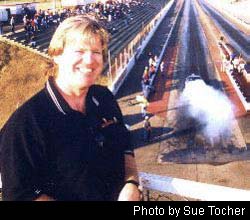
Protecting Outlaw 10.5 from itself
2/8/06

![]() f
you want to see Outlaw 10.5 racing the way it was meant to be, better
get out to the track this year. Otherwise, I fear you may eventually find
just another Baby Pro Mod class in its place.
f
you want to see Outlaw 10.5 racing the way it was meant to be, better
get out to the track this year. Otherwise, I fear you may eventually find
just another Baby Pro Mod class in its place.
Since its inception Outlaw 10.5 has existed with minimal rules: stock-appearing bodies, stock firewalls, stock front frame rails with stock-type suspension mounted in the original locations, and put the power to the pavement through 10W tires. Oh yeah, and ‘Run what ya’ brung, an’ hope ya’ brung enuf.’ Other than the usual safety requirements, that was about it. Pretty simple and straightforward.
Of course, racers being racers you just know they’re going to stretch the envelope. That inclination leads to some pretty creative interpretations of the rules. With full tube chassis banned, some take a tube car and effectively “front-half” it, replacing everything from the firewall forward with stock appearing pieces, or they start altering how much of the frame rails are retained, or they create elaborate bracket-and-arm systems to physically move suspension components while technically retaining the stock mounting points. You get the idea.
Now, some of the engineering is quite impressive in its execution and certainly worthy of admiration for its ingenuity, but still, it’s designed to circumvent or at least redefine the rules. And that’s a problem, especially if the trend is allowed to continue unabated.
Recently, I read an online debate over what should or shouldn’t be allowed in 10-wide chassis construction, with some people advocating a full tube set-up, others insisting only original equipment should be retained, and most falling somewhere between the two. Regardless, everyone agreed that whatever rules are adopted, they must be enforced. That’s easy to say, but the fact of the matter is that many current outlaw cars were built in widely disparate styles before most sanctioning bodies even paid them any attention, so it’s inherently difficult to cover them all with one set of rules.
That’s going to have to change, though, as more and more cars are being built to the rules that currently exist. In fact, it’s already at the point where if a car doesn’t have all the latest chassis tricks incorporated, it’s likely not going to be competitive at the highest levels. So, whatever rules are made now will determine the look of the class in the future. Caution is advised—no, make that required.
I’ve always felt—and I think most fans agree—that the appeal of 10-wide racing is the wheelstanding unpredictability of these stock-appearing cars. Take that away, as tube chassis and advanced suspensions would undoubtedly do, and all you’re left with is another fast doorslammer class, not all that different from Pro Street, Top Sportsman, or Pro Mod. Sure, the drivers might enjoy a quicker, more predictable ride, but I’m quite convinced the fans would rather see these guys run 4.40s and .50s in the eighth with the wheels hanging high all day long than a series of string-straight 4.30s in cars that launch like Pro Stockers.
Just consider the history of NHRA’s Super Stock A/Automatic cars, once the absolute darlings of fans and media alike with their stock body lines and wheels-up launches (sound familiar?), but once some of the racers decided they had to go quicker and started tying down the front ends to control the launch … well, when’s the last time you saw a non wheel standing Super Stock/AA on anything but a MOPAR magazine cover? 'Nuff said.